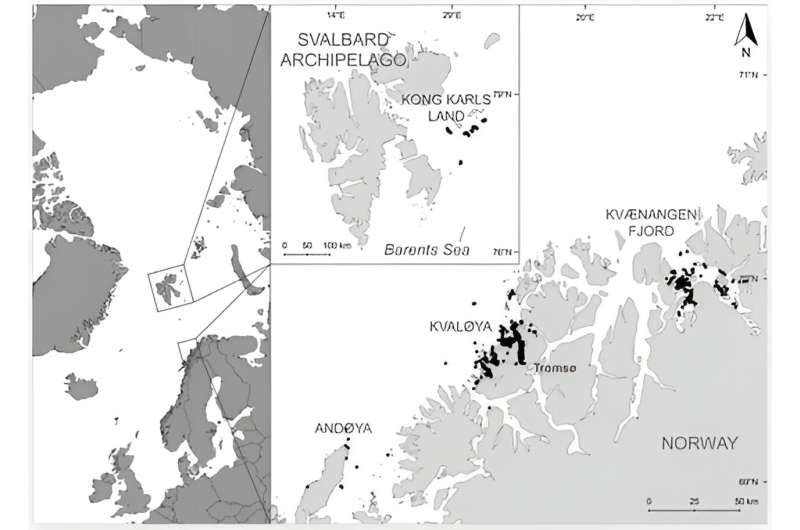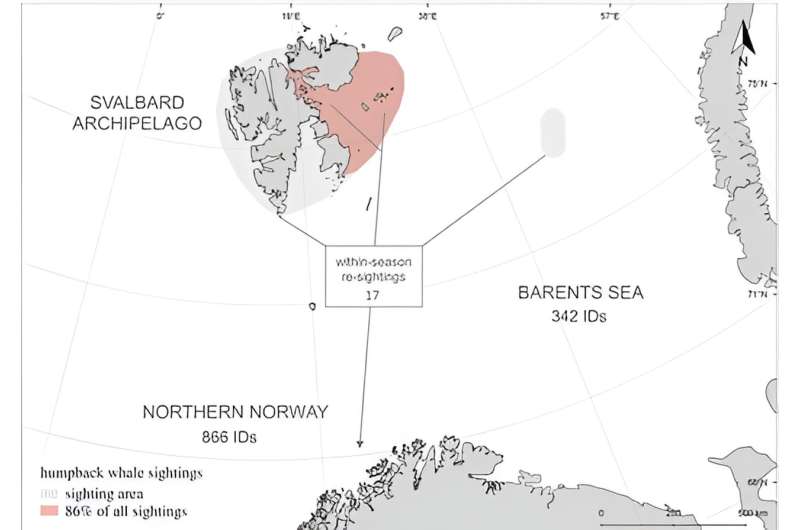September 11, 2023 feature
This article has been reviewed according to Science X's editorial process and policies. Editors have highlighted the following attributes while ensuring the content's credibility:
fact-checked
peer-reviewed publication
trusted source
proofread
'Let's stop for a bite along the way': Why it's important to understand Arctic whales' migratory foraging habits

In the ocean, both natural and human-driven factors may cause ecosystems to undergo transformations. Such changes, whether sudden or gradual, can affect the food web by causing redistribution of prey upon which seasonal predators, such as migrating whales, depend. A prey redistribution of this kind may not only lead predators to shift their migration routes and timing, but also to adapt their foraging habits.
An international team of researchers from Norway, the U.K., and the U.S. has studied the foraging habits of humpback whales (Megaptera novaeangliae) in the Barents Sea, north of northern Norway. These whales typically spend summer and autumn foraging in the Barents and Norwegian Seas before migrating to the West Indies and the Cape Verde Islands for mating and breeding during spring months.
The team's work, titled "Don't mind if I do: Arctic humpback whales respond to winter foraging opportunities before migration," is published in Royal Society Open Science.
According to existing research, significant numbers of humpback whales have not been observed in the northeastern Atlantic since the time of commercial whaling in the area between 1881 and 1904, when forage fish were known to be plentiful there.
However, during this study, the researchers documented individual whales—first seen and identified during summer in the Barents Sea—spending the winter in northern Norway, foraging on Norwegian spring-spawning herring (Clupea harengus). These herring are also known to have begun overwintering in the area—along the whales' migration route—in considerable numbers since 2010.

The team collected biopsy and photographic evidence of humpback whales in the Barents Sea near the Svalbard Archipelago and in several fjords of northern Norway at various points between 2010 and 2019. Owing to the warmer water of the north Atlantic, the area of northern Norway is free of sea ice in the winter, and between June and December, the waters of the Svalbard Archipelago are typically also ice-free.
Intra-seasonal data matches of whale observations made in the Barents Sea and northern Norway showed that during their migration, some of the whales continued foraging in the northern Norwegian fjords.
The researchers documented a preponderance of females during their winter observations in northern Norway, and estimated a higher winter pregnancy rate there than earlier in the season. From this they deduced that pregnant females—whose gestation period lasts between 10 and 13 months—may be especially prone to continue their foraging season in northern Norway, in order to maximize their energy.
In addition, the study notes that the whales began feeding in the northern Norwegian fjord area in 2010, concurrent with significant concentrations of herring there. According to a 2017 study in Mammalian Biology, humpback whales were not present in the area before then, as this herring stock mostly overwintered in fjords situated further south.
Why is this important? The current study observes that "winter foraging on fjord-based herring is a strategy that is preferentially used by female humpback whales in northern Norway. Our findings suggest that this strategy has become an important annual event for humpback whales, contingent on herring overwintering in these fjords."
On a larger scale, it will be important for future studies to consider and assess the effect of human-driven factors on migratory species, especially in their crucial feeding areas. Though a commercial whaling moratorium issued by the International Whaling Commission has been in place since 1985, M. novaeangliae are still endangered in some areas, including Cape Verde. The researchers stress that management of ecosystems should specifically prioritize shipping and fishing activity.
More information: Lisa Elena Kettemer et al, Don't mind if I do: Arctic humpback whales respond to winter foraging opportunities before migration, Royal Society Open Science (2023). DOI: 10.1098/rsos.230069
Journal information: Royal Society Open Science , Mammalian Biology
© 2023 Science X Network

















